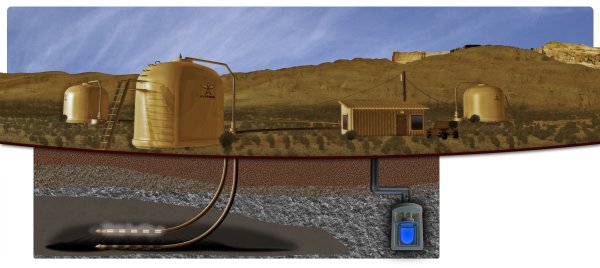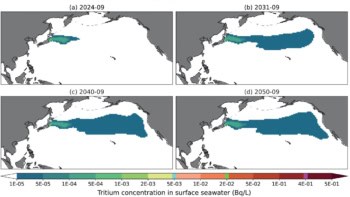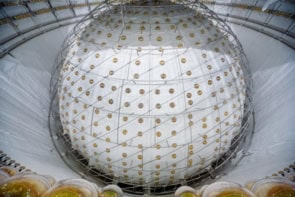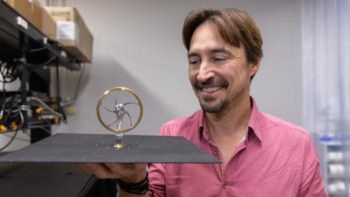
Nuclear power is normally associated with gigawatt-scale facilities costing billions of dollars and run by armies of scientists and engineers. But some in the nuclear industry have long argued that much smaller, unmanned reactors could play a role too. Such reactors, which would have power outputs of only a few tens of megawatts, would be particularly suitable for people or companies in remote parts of the world.
Now, however, Hyperion Power Generation — a US company based in New Mexico — has brought the dream of tiny nuclear reactors one step closer with its Power Module. This nuclear reactor — or “battery” as the firm calls it — is not much larger than a hot-tub and could supply thermal energy at a rate of about 70 MW. That could be converted into about 27 MW of electricity, which would be enough to supply about 20,000 US households.
Unlike conventional nuclear power plants, Hyperion’s reactor uses uranium hydride, which is essentially enriched uranium metal that has absorbed a large amount of hydrogen. As the uranium nuclei decay by fission, they release neutrons that are slowed down by the hydrogen, which acts as the moderator. The slow neutrons can then split further uranium nuclei and trigger a chain reaction.
No moving parts
The novel feature of the reactor is that the power output is kept steady without the need for any moving parts, flowing water, or human intervention. If the uranium hydride gets too hot, the hydrogen is driven out of the uranium metal and the chain reaction stops. But as the system is sealed, the hydrogen flows back into the uranium when it has cooled, allowing the reaction to restart. The up-shot is that the temperature and concentration of hydrogen stabilize, although if the sealed core is breached for any reason, the hydrogen will escape and fission stops.
Heat from the reaction is removed by liquid metal flowing in pipes with mesh wicks. According to the firm, these sealed systems are about 1000 times better than solid metals in transferring heat. Using these pipes is also an important safety feature because they keeps water, which can act as a moderator and slow down the neutrons (thereby speeding up the chain reaction), well away from the reactor core.
The technology was first developed by Otis Peterson and colleagues at Los Alamos National Laboratory in the US and then licensed to Hyperion, which was set up in 2006 to commercialize the technology. Peterson retired from the lab in 2006 to join the company as its chief scientist and in April 2008, the US-based venture-capital firm Altira Group invested several million dollars in Hyperion, which has 100 employees.
Eastern European launch in 2013
The firm says it will have a prototype of its reactor fully-designed next year and that it has already secured an order for six units from a group of investors in eastern Europe, including the Czech engineering company TES, who have an option to buy a further 44. It also claims to have other commitments from various parties — mostly energy utilities that currently use diesel generators in remote locations — for a further 100 units. The company expects to deliver its first reactor in June 2013.
Reactors would be configured and sealed at its factory, which has not yet been built, before being shipped to customers. Installation would take as little as six months and a reactor could remain in place for at least five years before the spent reactor would have to be returned to the factory and recharged with fresh fuel.
Will licensing be a problem?
The firm says that it started the process of getting the reactor — which is expected to cost about $25m — licensed for use in the US about two years ago. However, Paul Norman, a nuclear-reactor physicist at Birmingham University in the UK, warns that licensing could be a problem because regulatory agencies are not used to evaluating such small systems for commercial use. While he thinks that the concept of a mini-reactor is reasonable in principle, he believes that conventional power sources could still prove more cost-efficient. “There is a reason why we have not seen such reactors before,” he said.
But Peterson says that licensing Hyperion’s reactor will not be stumbling block because regulators already know how to evaluate research reactors, which can be very different to conventional power reactors. Moreover, he points out that the reactor is designed to run on uranium that is enriched to 10%, which — although higher than the 5% enrichment in most commercial light-water reactors — is well below the 20% threshold for what is considered to be highly-enriched material and should not raise the hackles of security agencies.
Hyperion believes that its reactors are ideally suited for companies needing a source of power in remote areas, such as mining companies or those wishing to extract oil from, say, the Canadian oil sands — an application that Altira has long been interested in. This is an energy intensive process that is currently fuelled by natural gas. According to Peterson, the large quantities of greenhouse gases that are generated during extraction could be reduced greatly if a Hyperion reactor were used — although the company has no firm orders from the oil industry.
Peterson also says that the used uranium hydride could be heated to drive out the hydrogen, leaving enriched uranium that could be re-used as fuel in a conventional nuclear reactor. While the company is still working on a way of doing this that is commercially viable, Peterson says that the “physics exists” to do so.



